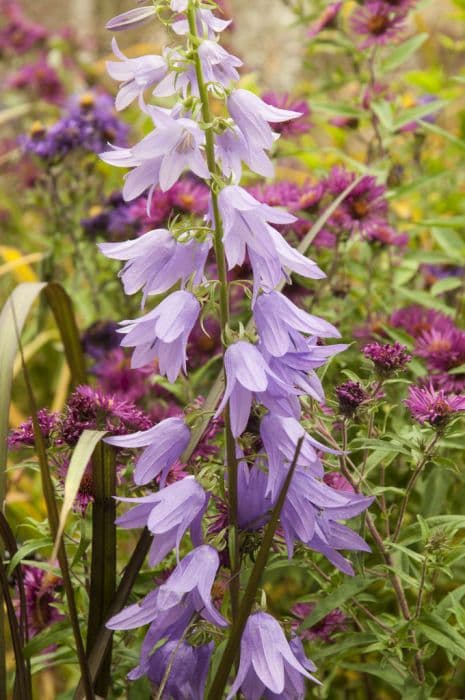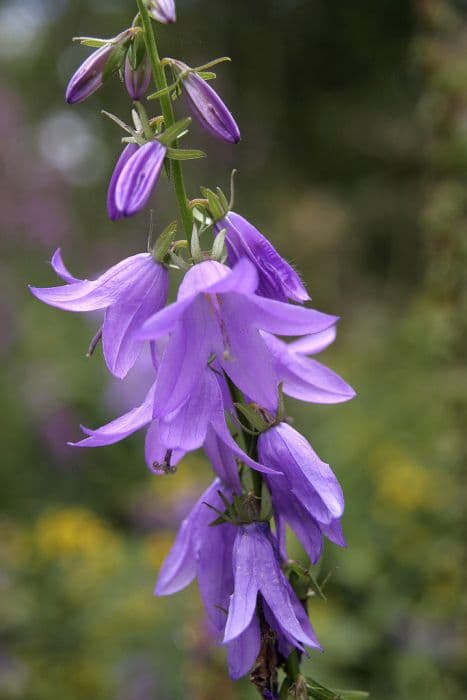Trailing Lobelia Lobelia richardsonii hort.

ABOUT
Lobelia richardsonii, commonly known as Richardson's lobelia, is a perennial flowering plant. This plant is characterized by its striking appearance, featuring clusters of vibrant flowers. The blooms are typically a brilliant shade of blue, with a prominent white or light center that gives them a distinguished two-tone appearance. Each individual flower on Richardson's lobelia is tubular, with two lips; the upper lip is typically split into two sections, while the lower lip may be divided into three lobes, which are sometimes elegantly splayed outwards. The leaves of Richardson's lobelia are generally lance-shaped and can vary in color from green to a reddish-purple tint, depending on various factors such as sunlight exposure. The foliage grows in a basal rosette at the base of the stem and along the stem as well. The leaves along the stem are alternately arranged and can clasp the stem at their base. This plant's stem is erect and sturdy, branching out to display the flowers in a visually pleasing manner. The overall form of Richardson's lobelia is one of graceful vertical lines, with the flower clusters typically arranged in a loose, elongated spike at the top of the stems. The beauty of Richardson's lobelia is showcased in various settings, such as wildflower gardens, borders, or along the edges of ponds where its colorful display adds a touch of elegance. Despite the absence of discussion on its dimensions, the lush and vibrant appearance of Richardson's lobelia makes it a desirable addition to gardens and natural landscapes.
About this plant
 Names
NamesFamily
Campanulaceae.
Synonyms
Richardson's Lobelia, Great Lobelia.
Common names
Lobelia richardsonii hort.
 Toxicity
ToxicityTo humans
The Lobelia, commonly referred to for this species, contains several alkaloids that can be toxic to humans if ingested in sufficient quantities. Symptoms of Lobelia poisoning can include nausea, vomiting, diarrhea, coughing, dizziness, tremors, and an increased heart rate. In severe cases, excessive consumption can lead to convulsions, coma, and even death. It's important to handle Lobelia with care and avoid ingesting any part of the plant.
To pets
The Lobelia is also considered toxic to pets. If a pet ingests a part of this plant, they could experience symptoms such as excessive drooling, vomiting, diarrhea, lethargy, or abnormal heart rate. In cases of significant ingestion, the symptoms could escalate to severe illness or even be fatal. It's crucial to keep Lobelia out of reach of pets and to consult a veterinarian immediately if you suspect your pet has ingested any part of this plant.
 Characteristics
CharacteristicsLife cycle
Perennials
Foliage type
Deciduous
Color of leaves
Green
Flower color
Blue
Height
2 feet (0.61 meters)
Spread
2 feet (0.61 meters)
Plant type
Herb
Hardiness zones
5
Native area
North America
Benefits
 General Benefits
General Benefits- Ornamental Appeal: Lobelia richardsonii, commonly known as Richardson's lobelia, adds visual appeal to gardens with its showy flowers and attractive foliage.
- Attracts Pollinators: The plant is known to attract butterflies and bees, which can help pollinate other plants in the garden.
- Drought Tolerant: Richardson's lobelia has the ability to withstand periods of low water availability, reducing the need for frequent irrigation.
- Low Maintenance: It requires minimal care once established, making it a convenient choice for gardeners of all skill levels.
- Adaptable Growth: The plant is able to thrive in a variety of soil conditions and climates, allowing for versatility in landscaping design.
- Seasonal Color: With its vibrant flowers, it provides seasonal color to gardens and landscapes, often blooming from late summer into fall.
- Wildlife Habitat: It can serve as a food source and habitat for local wildlife, supporting biodiversity.
- Erosion Control: Richardson's lobelia can be used to help control soil erosion because of its root system that stabilizes the ground.
 Medical Properties
Medical Properties Air-purifying Qualities
Air-purifying QualitiesThis plant is not specifically known for air purifying qualities.
 Other Uses
Other Uses- Lobelia richardsonii, commonly known as Richardsons lobelia, can be used for educational purposes to demonstrate plant structure and flower anatomy to students and gardening enthusiasts.
- The plant can serve as habitat and food for specific caterpillar species that feed exclusively on Lobelia leaves before their metamorphosis into butterflies or moths.
- Landscapers may use Richardsons lobelia for controlling erosion on slopes due to its root structure which helps to stabilize the soil.
- In floral art and decorations, the vivid color of Richardsons lobelia flowers can be utilized to add depth and contrast in flower arrangements.
- Gardeners may cultivate Richardsons lobelia as a challenge to improve their skills, as lobelias have a reputation for being somewhat tricky to grow successfully.
- Richardsons lobelia can act as a natural pest deterrent in gardens, as some insects avoid the plant due to its specific chemical properties.
- The flowers of Richardsons lobelia can be used to create a natural dye for coloring fabrics and yarns with shades of blue and violet.
- Cooking enthusiasts might use the flowers of Richardsons lobelia as an edible garnish for salads and desserts, provided they are free from pesticides and considered safe to eat.
- In photography, the striking appearance of Richardsons lobelia can be captured to create botanical prints and wall art that bring a touch of nature indoors.
- The plant can play a role in permaculture designs by attracting beneficial pollinators like bees and butterflies to support the ecosystem of a garden.
Interesting Facts
 Feng Shui
Feng ShuiLobelia is not used in Feng Shui practice.
 Zodiac Sign Compitability
Zodiac Sign CompitabilityLobelia is not used in astrology practice.
 Plant Symbolism
Plant Symbolism- Healing: Lobelia, also known as Indian tobacco, has been traditionally used for its medicinal properties, symbolizing the potential for healing and recovery.
- Protection: Some cultures used Lobelia to ward off storms or evil spirits, representing a symbol of protection and safety.
- Love: Due to its vibrant flowers, Lobelia can symbolize love and attraction, showcasing the beauty and passion in relationships.
- Persistence: As a plant that can grow in challenging conditions, Lobelia symbolizes determination and the ability to overcome obstacles.
 Water
WaterThe plant commonly known as Lobelia should be watered regularly to maintain moist but not waterlogged soil. During the growing season, you may need to water Lobelia approximately twice a week, depending on the climate and weather conditions. Adjust your watering schedule to reduce frequency during cooler months. As for the amount, start with about 1 inch of water per week, monitoring the soil moisture to determine if adjustments are needed. Over-watering can lead to root rot, so it's essential to ensure good drainage for the plant.
 Light
LightLobelia thrives best in partial shade to full sun conditions. It's ideal to place Lobelia where it can receive morning sunlight and some afternoon shade, especially in areas with hot summers. The plant will benefit from bright light for at least 6 hours a day to promote healthy growth and abundant flowering.
 Temperature
TemperatureLobelia prefers cool to moderate temperatures and will flourish in environments where the temperature ranges between 55°F and 70°F. While it can survive minimum temperatures down to 20°F, frost can damage the plant. During the summer, temperatures should ideally not exceed 75°F for sustained periods as heat stress can affect its growth and blooming.
 Pruning
PruningPruning Lobelia helps to encourage bushier growth and to maintain a neat appearance. Trim back the stems after the first flush of flowers begins to fade to promote a second blooming. The best time for heavy pruning is late winter or early spring before new growth starts. Light pruning can be done throughout the growing season to remove spent flowers and yellowing leaves.
 Cleaning
CleaningAs needed
 Soil
SoilLobelia cardinalis, commonly known as cardinal flower, thrives best in a moist, well-draining soil with high organic matter. The ideal soil pH for this plant is between 6.0 and 7.5. A mix of peat, loamy garden soil, and a bit of sand or perlite to enhance drainage would be suitable.
 Repotting
RepottingCardinal flowers (Lobelia cardinalis) generally do not require frequent repotting and can be repotted every 2 to 3 years, or when the plant becomes root-bound or the soil appears depleted.
 Humidity & Misting
Humidity & MistingLobelia cardinalis prefers a humid environment, benefits from increased humidity levels, ideally between 40-70%.
 Suitable locations
Suitable locationsIndoor
Keep Lobelia cardinalis in bright, indirect light with moist soil.
Outdoor
Plant Lobelia cardinalis in partial shade and keep soil consistently moist.
Hardiness zone
3-9 USDA
 Life cycle
Life cycleLobelia richardsonii, commonly known as Richardson's lobelia, begins its life cycle as a seed, which upon germination in suitable conditions, develops a root system and a shoot that emerges from the soil. The shoot grows into a seedling, producing leaves and establishing itself. As it matures, the plant forms a rosette and elongates its stem to transition into the vegetative stage, where the focus is on leaf growth. Upon reaching maturity, Richardson's lobelia enters the flowering stage, producing distinct flowers that are capable of attracting pollinators for sexual reproduction. After pollination, the flowers produce fruits, typically capsules, that release seeds when mature, thereby completing the cycle. The plant may also spread vegetatively through root division or stem cuttings if conducive environmental conditions are present.
 Propogation
PropogationPropogation time
Spring to early summer
Propogation: The Lobelia, specifically Lobelia richardsonii hort., can be propagated through seed sowing. The most popular method of propagation for this plant is by sowing seeds indoors before the last frost of the season. To propagate by seed, first prepare a tray with well-draining potting mix and scatter the seeds thinly across the surface. Lightly press the seeds into the soil, as lobelia seeds require light for germination and should not be covered. Maintain a consistent moisture level and a temperature around 70 to 75 degrees Fahrenheit (21 to 24 degrees Celsius) until germination, which typically occurs within 2 to 3 weeks. Once seedlings emerge and reach a sufficient size, they can be transplanted to their final location in the garden or outdoor containers.





![Trailing lobelia [Techno Heat Trailing Light Blue Improved]](/_next/image?url=https%3A%2F%2Fplants-admin.emdemapps.com%2Fimages%2Fplants%2F%2Fimages%2F604b65196de60.png&w=640&q=75)



